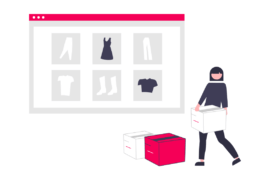To win over your customers, you need to constantly find new ways to reach out to your leads. Look at the best B2B marketing techniques you can use.
Do you know what it takes to create winning b2b marketing strategies?
It begins with defining your target audience, segmenting them, and reaching out to potential customers or clients across multiple touchpoints. This is the same for B2B marketing as well.
The only way B2B marketing strategies differ from B2C marketing is how a business communicates with its audiences. While most marketing channels remain the same, B2B customers have a complex buying journey. It involves more lead nurturing than B2C marketing and in-depth market research to enhance customer experience.
While this is the groundwork for defining your marketing strategy, the COVID-19 pandemic has made many marketers rethink their B2B strategies for the future.
There’s a need for innovative strategies to engage their audiences.
So let’s look at some of the best B2B marketing strategies you can deploy this year.
But wait…
Also Read: 5 Ad Engagement Strategies to Test Now
Why Is B2B Marketing Strategy So Important?
When you design a B2B marketing strategy, you can run multiple tests and see what really works for your audience. This also helps you experiment with new and innovative ideas that might not have been tested before.
It not only gives you an edge over your competitors but also saves you valuable time and money by avoiding possible pitfalls. You can continually improve your existing and upcoming campaigns, helping you reach your marketing goals faster.
10 Effective B2B Marketing Strategies to Experiment With
- Create an Omnichannel Presence
Omnichannel refers to a multichannel approach to sales that focus on providing a consistent customer experience whether the client is shopping in-store, online, or via a mobile app. In today’s fast-paced world, especially after the COVID-19 pandemic, it has become crucial to communicate with customers at multiple touchpoints.
In fact, 64% of B2Bs intend to increase the number of hybrid sellers over the next six months. Hybrid seller refers to the model where the sales reps interact with their clients via phone, apps, in-person visits, and video.
Look at the graph below. It clearly shows the different channels that B2B companies are using to sell their product or service today.Source: McKinsey & Company
Today, B2B buyers easily switch between their choice of channel – social media, WhatsApp messaging, in-person meet, and more – based on convenience and timing. For B2B organizations to succeed, they need to embrace this new shift and enable integrated interactions across all channels.
Using an all-in-one CRM software that easily accommodates various automation tools such as billing software, WhatsApp marketing software, inventory management solution, and more can help streamline the entire selling process and make it more efficient.
Sales teams need to embrace new skills and technology to take full advantage of B2B omnichannel marketing. This would allow for a better customer experience by providing a consistent experience across all touchpoints. - Leverage the Video Marketing Trend
Video marketing is another excellent B2B marketing strategy that has emerged as one of the most popular trends in the B2B space and is increasingly being used by companies. A survey revealed that 84% of consumers are more likely to buy a product or service after watching a video.
Video marketing activities are perfect for capturing your audience’s attention. Today, people have neither the time nor the patience to read long-form articles due to the abundance of new content.
In fact, Cisco predicted that video would account for 82% of all online traffic by the end of 2022. Your company needs to stay on top of the best video marketing practices to increase sales.
When you develop your video content strategy, target your buyers at various stages of their buying journey.
Create videos that educate or engage your audience emotionally to hook their attention.
Video ads and marketing strategies require a lot of creativity to stand out, and this B2B marketing trend isn’t going away anytime soon. - Use Referral Marketing
Referral marketing refers to recommendations and word-of-mouth to expand a business’s customer base using the network of its existing clients.
Referral marketing helps you retain existing customers and acquire new clients without too much effort. All you need is for your customers to spread the word about your brand to other people and inform them about your products and services and how they would benefit them.
This way, you can slowly build your brand reputation within a specific area as well as an understanding of your expertise among people that have not worked with you directly.
Also Read: 5 Best High-Ticket Affiliate Marketing Platforms in 2022 - Leverage Social Media Marketing
It may seem unlikely that a business would use social media to research a product or service. However, a whopping 75% of B2B buyers and 84% of C-Suite executives browse various social media platforms before purchasing.
Today, many people are active on at least one social media channel. Many studies have shown that most consumers research brands on social media, making it an important source of information. Social media helps companies connect with other businesses directly, stay updated with market trends, and build an online brand.
Although LinkedIn might seem to be the most effective channel for B2B marketing, you can also leverage platforms such as Instagram, Twitter, and WhatsApp marketing software to attract clients. - Execute PPC Campaigns
While organic marketing is important, you can’t ignore paid advertising.
Running pay-per-click or PPC campaigns is an effective measure to increase your online presence. PPC helps you publish your content and brand on various digital platforms, including search engines and social media.
Rather than just promoting your products or services, PPC helps you reach your audience better by targeting relevant categories, including buyer persona data, and posting content that people can relate to. - Run B2B Email Marketing Campaigns
The pandemic dramatically affected offline marketing channels while digital marketing continued to grow. Of course, not every channel could absorb a higher budget allocation and maintain a positive ROI.
But this isn’t the case with email marketing. You can easily increase campaign volume by increasing the email frequency while you continue to get results. More than 59% of B2B marketers say email is their biggest source of ROI.
But these marketing efforts can underperform if your database is out-of-date or incomplete. Many B2B companies do not get the desired result due to data quality – they have a lot of spammed email addresses in their database, leading to an increased bounce rate.
Fortunately, many email marketing software available in the market automatically updates your contact database with the latest information. Besides, you can use it to segment your audience on various factors to send out targeted, personalized emails.
To make the most of B2B email marketing, you must be careful about the quality of the content you deliver to your audience. Having a targeted email list will be a good start for providing value to your prospects or leads.
One fact that remains is that email marketing will continue to grow. So keep testing your subject lines and call-to-action buttons and further optimize your campaigns to yield the maximum results. - Allocate Resources to Search Engine Optimization
Search engine optimization, or SEO, is a crucial marketing strategy for B2B and B2C companies. Using SEO, you can optimize your website’s content to generate more traffic.
SEO helps you design your content by including keywords and phrases frequently researched by people online.
By making your content SEO-friendly, you can rank higher on internet searches and get more visitors to your website. This, in turn, helps your business capture more leads and acquire new customers.
Also Read: 10 SEO Experts Reveal Their Keyword Research Techniques - Incorporate Real-time Personalization into Your Website
Website personalization ensures maximum impact if you seek long-term relationships with your potential clients.
Website personalization is the practice of designing a customized experience for your users when they visit your website. So instead of having a general interface for all customers, your website will create a customized web page interface based on the visitor’s profile.
93% of businesses have seen a drastic conversation rate growth due to B2B website personalization. You can easily customize your website content for each unique set of visitors using automated tools like HubSpot, Marketo, and more.
Your website uses location, IP addresses, and domains to recognize where these visitors are coming from. Then, it shows the visitors text and relevant images and filters out content that is less likely to pique their interest. - Conduct a Competitive Analysis
While performing market research, don’t forget to conduct a competitive analysis. Competitive analysis helps you understand other players in the market and who your main competitors are.
Also known as SWOT analysis, understanding your competition helps you understand their strengths, weaknesses, and potential opportunities and threats to your business. You can start by asking questions such as the products and services your competitors are offering, their marketing tactics, whether they have an online presence, and past performance or results. - Promote Account-based Marketing (ABM)
ABM, or account-based marketing, is another innovative trending strategy in the B2B space as it enables higher revenues in a shorter time frame. It allows marketers to target and engage a focused set of target audiences with highly personalized content, which increases the chances of higher conversions.
You can use a variety of tactics to stimulate interest from your ideal customer profile, such as social selling, direct mail, and video prospecting. A study by Oracle and Argyle among B2B marketers revealed that 48% of respondents believe that ABM is an effective tool for the B2B marketing strategy.
Clearly, you don’t want to be left behind.
Wrap Up
If you want to win over your customers, you must keep finding ways to reach out to your leads. Our business landscape is constantly evolving, and it’s crucial to keep up with the advancement of new technology. So whether you want to create a podcast, run live streaming, or leverage B2B influencer marketing, you do not hesitate to experiment with new ideas.
Marketing is a never-ending process, and you need to focus on how you can deliver value to your potential clients while providing a smooth customer experience.
FAQs
B2B marketing generates demand for products and services from other businesses. As with B2C (business to consumer) marketing, B2B marketing utilizes multiple online and offline channels and includes many types of content.
Any marketing strategy or content used by one business to target and sell to another. B2B marketing is typically used by companies that sell services, products, or SaaS to other companies. Monday.com’s B2B brand strategy on LinkedIn is one example of B2B marketing.
Below are four basic types of B2B customers: producers, resellers, governments, and institutions.

Shubham is a digital marketer with rich experience working in the advertisement technology industry. He has vast experience in the programmatic industry, driving business strategy and scaling functions including but not limited to growth and marketing, Operations, process optimization, and Sales.





![28 Best Supply Side Platforms (SSP) for Publishers in 2024 [The Complete List] Supply Side Platforms](https://www.adpushup.com/blog/wp-content/uploads/2022/05/undraw_chore_list_re_2lq8-270x180.png)

